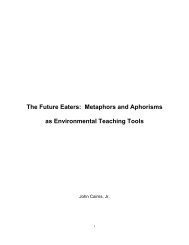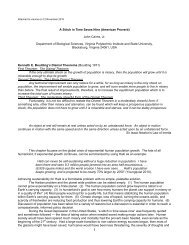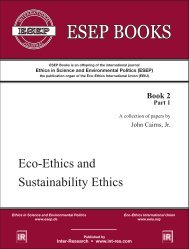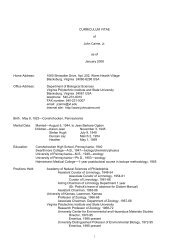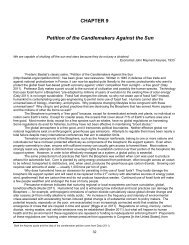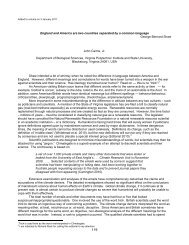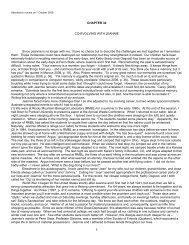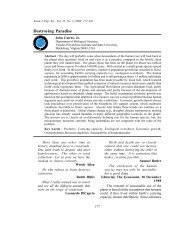View - ResearchGate
View - ResearchGate
View - ResearchGate
Create successful ePaper yourself
Turn your PDF publications into a flip-book with our unique Google optimized e-Paper software.
178Cairns: Eco-Ethics and Sustainability Ethicssustainability strategies are progressing satisfactorily, but “top-down” (i.e., system level) sustainabilitystrategies are not. Furthermore, the connections between these two strategies are largelyunexplored (Cairns 2003c). Worse yet, there is strong opposition to abandoning unsustainablepractices. Sustainable practices are more favorable to maintaining peace because they diminishbut do not eliminate resource wars.POLICY ISSUESThe policy of expecting perpetual growth on a finite planet is no longer tenable and shouldhave been abandoned in the 20th century. Although Ruth Patrick advocated “use without abuse”of natural systems in 1948, the concept of sustainability originated with Brown (1981). He defineda sustainable society as one that is able to satisfy its needs without diminishing the options offuture generations. Years later the definition (somewhat modified) was used by the World Commissionon Environment and Development (WCED 1987) in a report that received much internationalattention.It is abundantly clear, however, that most individuals and their leaders the world over have littleor no literacy in sustainability. Most people would probably endorse Brown’s (1981) definition ofsustainability. Many more, including corporations, would endorse the WCED (1987) definition,since the word sustainable is used as an adjective to define the noun development and this nounis strongly associated with growth, which is the world’s dominant paradigm at present.In the United States, a major belief is that present practices need only be modified to be sustainable— hence the term “smart growth.” This conviction is usually accompanied by the concomitantbelief that technology will provide the solution to even the most intractable problems, i.e.,biotechnology will solve the food shortage and even the water shortages (e.g., treating unpotablewater). As a consequence, few (if any) nation-states have in place and are implementing a broad,“top-down” sustainability strategy. Furthermore, effective implementation will require more knowledgeof component parts (e.g., sustainable transportation) than is now available. Fortunately, thereare a number of steps toward sustainability that could be implemented at once while a global, “topdown”sustainability policy is being developed.ACHIEVING PEACE VIA SUSTAINABLE USE OF THE PLANET– Diminish the probability of resource wars by moving toward a more fair and equitable allocationof resources.– Preserve Earth’s ecological life support system by allocating more than 12% of the totalresource to this purpose.– Cease immediately all environmentally perverse government subsidies (Myers and Kent 2001),but expect a fierce fight from the special interest groups that benefit from subsidy dollars.– Stay within carrying capacity. The carrying capacity of ecoregions, nation-states, and theplanet should be more precisely defined in terms of sustainable use, focusing on maximumcapacity (low quality of life) and optimal capacity (high quality of life).– Stabilize human population size and even reduce it if it exceeds carrying capacity. With regardto exponential growth of the human population size, one is reminded of the tale of an elephantin a small room — everyone sees it, but no one wants to talk about it.– Achieve zero net immigration. Zero net immigration should be enforced by all nation-states(e.g., Browne 2002). Mass immigration, both legal and illegal, makes a mockery of attemptsat population stabilization. Arguably, even more serious is that immigration encourages



